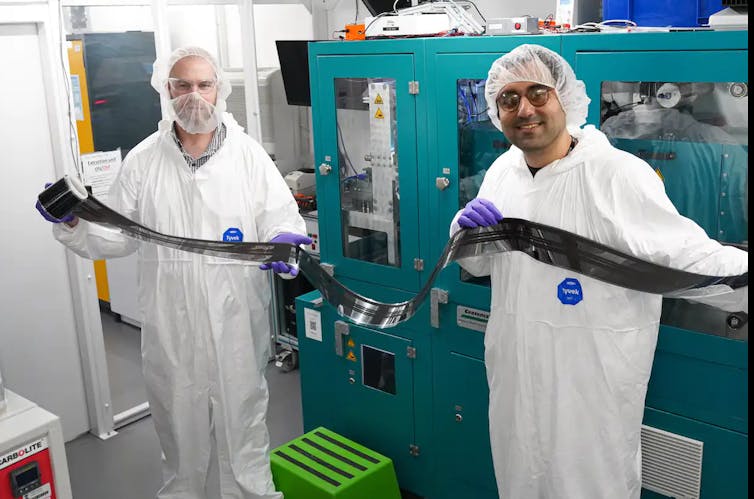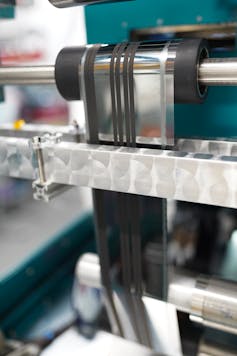Perovskite: new type of solar technology paves the way for abundant, cheap and printable cells

Silicon solar cells are an established technology for the generation of electricity from the sun. But they take a lot of energy to produce, are rigid and can be fragile.
However, a new class of solar cell is matching their performance. And what’s more, it can now be printed out using special inks and wrapped flexibly around uneven surfaces.
We have developed the world’s first rollable and fully printable solar cell made from perovskite, a material that is much less expensive to produce than silicon. If we can also improve their efficiency, this points to the possibility of making cheaper solar cells on a much greater scale than ever before.
The silicon solar cells that are so recognisable to us have a significant limitation. If enough were made to cover our needs, we could run out of the materials to make them by 2050. So, we need something new and lots of it. The perovskite solar cell is emerging to fill that gap.
Perovskite is a crystal structure made with inorganic and organic components, named after Lev Perovski, a Russian mineral expert of the 17th and 18th centuries.
Perovskite solar cells first appeared in research labs in 2012 and caught the attention of researchers due to two factors: their ability to convert sunlight into electricity, and the potential for creating them from a combination of inks.
In research labs, using highly controlled production methods in environments where oxygen and water are completely removed, perovskite solar cells can now match the electricity generation of silicon solar cells. This is a remarkable achievement.
But cheap perovskite solar cells that do away with silicon have yet to be manufactured on a commercial scale. So what if these materials could be produced using the same sorts of processes we use for printing ordinary packaging?

My colleagues and I recently demonstrated that a roll of plastic film can be loaded into a printing press, and working perovskite solar cells emerge at the other end. However, it’s not quite as simple as pouring ink into your desktop printer.
For one thing, scientists have found that to achieve record efficiencies, the semiconductor and perovskite layers in this new form of solar cell must be extremely thin – between 50 and 500 nanometres (about 500 times smaller than a human hair).
Also, the inks used to print them had required highly toxic solvents. But, after many years of effort, we have now formulated inks without toxic solvents that are compatible with the slot-die coating process – an established industrial technique originally used for the production of photographic film.
How our solar cell works
The printed perovskite layer generates free electrons from the energy provided by light hitting it. The semiconductor then prevents the perovskite re-absorbing these electrons with a good power conversion efficiency (the ratio of optical power in to electrical power out).
One problem remained: how to extract the electrical charge. In the past, this had been achieved by heating gold in a vacuum until it evaporated, and catching the vapour on the perovskite solar cell to form electrodes.
We took a different approach, creating a carbon ink compatible with both the perovskite material and the slot-die coating process. The result is large volumes of flexible, rollable solar cells that come out of the printing press ready to generate power.
More work needed
Perovskite solar cells have demonstrated high performance in research labs, and have now been proven capable of making the leap to high-volume manufacturing. But the job is not quite done yet.
The 10% power conversion efficiency achieved by these rollable printed cells is useful, and higher than the first commercial silicon panels. But it lags behind the typical 17% conversion efficiency of domestic solar panels in use today.
We know there are further increases available by taking advantage of higher-performing perovskite chemistry.
There is an engineering challenge to overcome in order that high-volume, commercially produced perovskite solar panels can match the energy generation of silicon. Further improvements in the lifetime stability of perovskite solar cells are also required – through a combination of chemistry, device design, and other strategies such as protective coatings and laminated barrier films.
In short, research needs to focus on converting what’s happening in the labs into real-world devices. But the possibility of producing hundreds of thousands of square metres of flexible perovskite solar cells is now a step closer.
David Beynon, Senior Research Officer at the SPECIFIC Innovation and Knowledge Centre, Swansea University
This article is republished from The Conversation under a Creative Commons license. Read the original article.




















